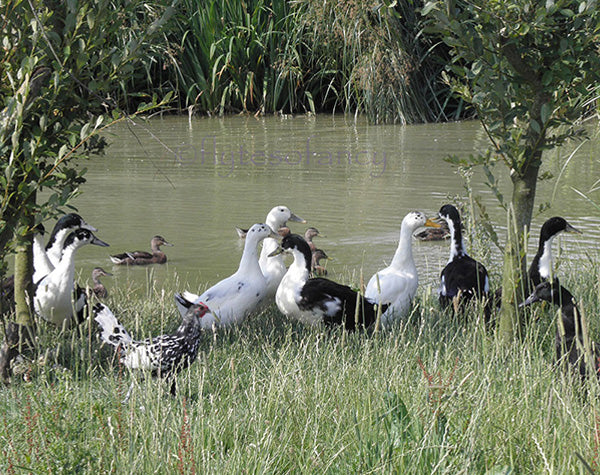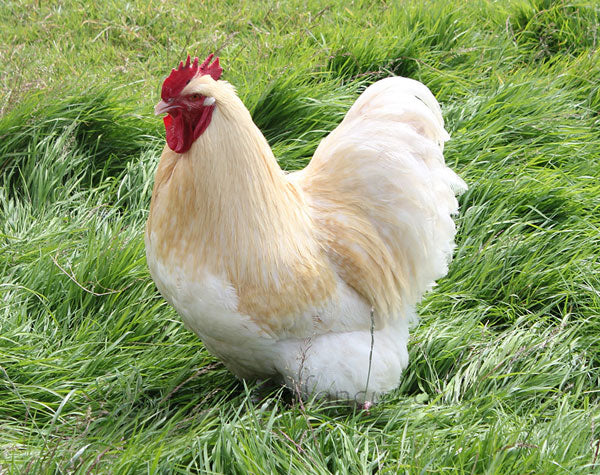Flyte so Fancy Ducks

Ducks have been a part of the flock here at Flyte so Fancy HQ for nearly as long as the chickens have.
These waddling, quacking, insouciant 'quackers' are the comedians of the Flyte so Fancy family, so much fun to watch. We also have annual visits from Moorhens, Swans, Canada Geese - and once, a confused Cormorant.
Living on our pond we have a small paddling of Cayugas, Mallards, Silver Appleyards and Cherry Valley crosses that hatched out from our flock, as well as several wild ducks who have made our pond their home (along with some very large carp!).
They happily dip, dabble and paddle around the pond all day long and live in the Floating Duck Lodge that sits in the middle of the pond.
Q:What are a group of ducks called?
A: On the pond, they are a paddling or a raft; on the ground (not unsurprisingly) a waddling.
Q: Can ducks fly?
A: Yes. All ducks have the potential to fly, but many domesticated ducks are too heavy or do not have a need to, so they don't. All wild ducks can fly and do as they migrate.
Which Type and Breed of Duck are best for you?

Ducks come in many shapes, colours, and sizes. There are the Mallards that we see dabbling up and down our ponds and rivers, to the upright stance of a Runner Duck hurtling across a garden, or to the wacky Muscovy.
All duck breeds descend from Mallard Ducks, except the Muscovy. Today, Mallards are still probably the most common duck you will see in the countryside.
In the wild, you will find breeds like Teal, Widgeon, Eider, Shoveler, and Shelduck are common – plus many more. Great places to see ducks in the wild are Waterfowl Reservations like Slimbridge (WWT) or West Sedgemoor (RSPB).
For thousands of years – believed to be over 4,000 – ducks have been domesticated (farmed). Firstly, in Asia, and then also by the Romans and Ancient Egyptians.
Domestication and breeding for specific traits have altered their characteristics. In many cases, because they have been bred as heavy meat birds, they can no longer fly. Today, Ducks are still bred worldwide for their meat, down and eggs.
Domesticated Duck Breeds are classified as Heavy, Light, Runners or Bantams. Probably the most well-known ducks are Aylesbury and Pekin that are Heavy Breeds. These White Ducks are mainly farmed for meat as they are not good layers.
Rouens and Saxonys also fall into the Heavy class and are kept mainly for meat. Or the Silver Appleyard that is not only a good meat bird but also lays lots of eggs.
Light ducks include Campbells (prolific egg layer at over 300 a year); Runner Ducks (very popular, many colours, good egg layer); Magpie Ducks (striking black and white plumage, very good layers); Welsh Harlequins (attractive ducks and so-so layers) and Orpingtons (a brown dual-purpose bird).
There are also Call Ducks, about the size of a pigeon, noisy but child friendly. They come in many colours (but are not a good layer). Please see our page on Duck Breeds for more detailed information.
At Flyte so Fancy, our pond is home to many Cayugas, Saxonys, Silver Appleyards and Cherry Valley Ducks – as well as Mallards (image above of Mallard pair in the Flyte so Fancy Garden stream).
Did you know - every year, globally, approx 3 billion ducks are slaughtered for meat.
Duck Housing

Duck housing is not the same as chicken housing as they have different requirements.
Ducks do not roost at night and so do not require perches. Equally, they will lay eggs anywhere, so do not need a specific nest box inside the house to do this.
Incidentally, Ducks do not always put themselves to bed in their houses as it gets dark, unlike chickens. You may be able to train some breeds to do this but, generally speaking, you would have to 'herd' them into the house in the evening.
If you keep them within a wire mesh run, it is perhaps more likely that they will go inside the house at night. If in a paddock with a large pond, they will probably float together on the pond at night, which will help to keep them safe from predators.
The guide of 1 sq foot of space inside a house for a chicken can be applied to ducks, depending on the breed of course. However, as they do not perch like chickens, it is a good idea to allow more floor space per bird.
Duck Housing should also be lower to the ground and have a large access door to allow easy exit. Ducks tend to act in a group (just a note - on the pond a flock of ducks is called a raft) so, a small duck house door can lead to a crush as they all try to go through the door at once.
Duck housing should also have plenty of ventilation. They are not particularly fussy about how messy they are, so ducks need a good airflow at night. The Large Classic Duck House with its sliding ventilation window is ideal.
If you have your housing on a float or an island in the middle of a pond, you will need to ensure you can get at it for cleaning. The Floating Duck Lodge (image above) comes with a cord to hold it in place so you can pull it back to the bank to make cleaning possible.
A pond is not absolutely essential if you wish to keep ducks. They do, however, need permanent access to a body of water for cleaning themselves.
This is important because they need to dunk their heads regularly to wash their eyes. A large bowl or a children's paddling pool make ideal 'ponds' for most duck breeds. If you are keeping some of the larger breeds, or a large number of ducks, then a proper pond may be necessary.
Finally, if you would prefer to keep your ducks enclosed within a fenced area, a 1m high fence is generally high enough to keep most breeds contained. Ducks are notorious wanderers (and yes, some can fly) and they can travel great distances if not penned. This puts them at risk from predators so containing them somehow is advisable. To keep predators out, however, a fence should be over 2m high.
Electric Netting is not recommended for ducks as they will try and barge their way through. Unfortunately, they can become entangled and then the repeated electric shocks can kill them. A wire mesh fence would be best but perhaps consider electric wires on the outside to keep out predators.
Interesting Duck fact: Aylesbury Ducks were so highly valued for their meat in the 18th & 19th centuries, that it was illegal to export them, or their eggs, from England.
Feed and Water for Ducks

Providing ducks with water so that they can keep themselves clean is especially important.
However, if this is their only source of water, it can quickly become muddy and, they will be drinking from the water they use for bathing. If you are only using a large plastic bowl or similar, for their supply of water, you will need to make sure that you regularly refill with fresh water.
A Poultry Drinker like a Honeypot Drinker or Gaun Tripod Drinker is ideal for ducks. They have enclosed tanks that give a constant supply of fresh water into the raised dish below. It will prevent the duck's water from becoming contaminated by their messy habits. Equally, we can suggest the BEC Auto Duck Drinkers as a way to keep drinking water clean.
Ducks are omnivores, like chickens, and will eat both insects and vegetable matter. Our Flyte so Fancy ducks eat Layers Pellets, the same as our hens, but you need to make sure that you provide a feeder that allows them to use their bills in a scooping action i.e. not one with an anti-flick grid.
There are specialist duck feeds available, such as the Fancy Feed Fenland Waterfowl Pellets, rich in proteins and oils, perfect for ducks.
If you are feeding ducklings a chick feed, you need to ensure that the feed you are giving them does not contain a Coccidiostat. This is a medication added into some feeds to prevent Coccidiosis, a common poultry disease.
Ducklings eat a greater quantity of feed than chicks and can overdose, going weak on their legs and becoming seriously ill. The Poultry Feeds we offer are all Coccidiostat free.
Q: What should you feed to Wild Ducks?
A: Nothing. Well meaning people will throw bread for them but there is no nutritional value in bread, or human junk food, for a duck's diet. It will fill them up and stop them foraging and eating what is good for them e.g pond weed, insects, worms, seeds.
Cleaning the Duck House

Keeping a duck house clean is an essential part of keeping your ducks in tip-top condition. They are particularly messy birds. You will want to make sure that the duck house provides adequate access, like removable panels.
The Classic Duck Houses, for example, have a removable side panel to allow good access to the inside, while the Puddleduck Duck House has a hinged roof allowing top-down access for cleaning.
Ducks do not perch when they sleep so, they lay and poo in the bedding in their house. We recommend that cleaning should be weekly, if not more often.
Simply add a good layer of bedding to the floor of the house (straw is popular and cheap, but Hemp Bedding is very absorbent and less smelly), then sweep this out and replace it at least weekly.
Duck houses tend not to suffer red mite infestations due to ducks thick, oiled feathers making it hard for the red mite to feed on them. However, when it comes to duck house hygiene, using a cleaner to remove any organic matter, bacteria or mould in the house is recommended.
Try products like Poultry Shield liquid, a sanitiser and degreaser, followed by a Coop & Run Sanitising Powder or Stalosan F Powder, both of which are super absorbent and will help to reduce the smell.
Unlike chickens, ducks are more likely to continue to lay their eggs throughout the winter months, although, it must be said, not necessarily where you can find them easily.
If you do collect enough eggs to consider selling them, then they do attract a premium price.

Duck eggs are larger than hen's eggs, with a larger yolk and a stronger shell but very tasty, and they make terrific cakes and bakes.
Before the arrival of hybrid hens in the 1950s, and their ability to intensively lay eggs, Ducks were the largest egg producers in the UK. But along came supermarkets with their requirements for larger volumes and, because it was harder to intensively 'battery farm' ducks, they were not so readily available.
Duck Eggs became less popular for a while but, these days, you cannot only buy them in some supermarkets, at a premium price but also from many local farm shops.
At Flyte so Fancy we offer Jumbo Egg Boxes to take eggs of that size and a personalised Egg Box Labels for Duck Eggs.
- - -
Basic Guide to Keeping Ducks ©Flyte so Fancy 2010. Updated 2021. Authors: Anne & Phillip Weymouth (Directors, Flyte so Fancy Ltd). Reproduction of part or all of this text is only possible with the express permission of Flyte so Fancy Ltd.


